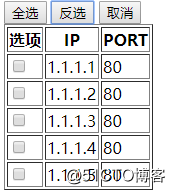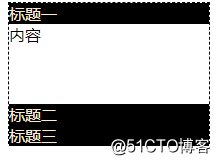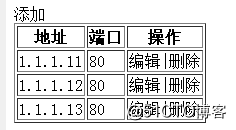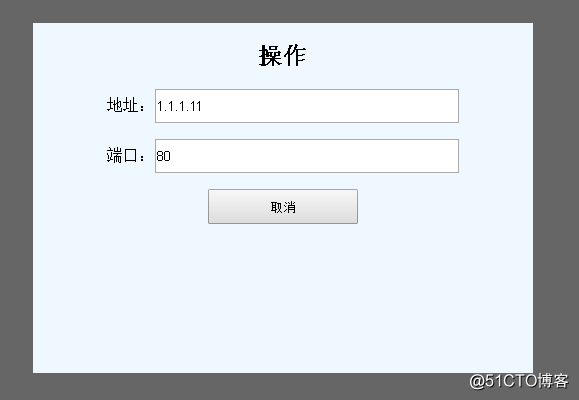1.选择器
1.1.id选择器
$('#id')1.2.class选择器
$('.cl')1.3.标签选择器
<div></div>
$('div')1.4组合选择器
<div id="i1">
<div class="c1">
<a>1</a>
<a>2</a>
<a>3</a>
</div>
</div>
$('#i1,.c1,a ') #i1和.c1和a的所有标签
1.5.层级选择器
<div id="i1">
<div class="c1">
<a>1</a>
<a>2</a>
<a>3</a>
</div>
</div>
$('#i1 .c1 a ') #i1下的.c1下的所有a标签(包括子孙后代)
$('#i1.c1>a ') #i1下的.c1下的所有a标签(只有儿子代)1.6.基本
:first $('#i1 .c1 a:first') #i1下的.c1下的第一个a标签
:last $('#i1 .c1 a:last') #i1下的.c1下的最后一个a标签
:eq() $('#i1 .c1 a:eq(1)') #i1下的.c1下的最后一个a标签1.7.属性
$('[name]') 具有name属性的所有标签
$('[name="user"]') name属性等于user的标签1.8.筛选器
<ul>
<li></li><li></li><li id="i1"></li><li></li>
</ul>
$('i1').next() #下一个
$('i1').prev() #上一个
$('i1').parent() #父标签
$('i1').children()#子标签
$('i1').siblings()#兄弟标签2.操作实例
<body>
<input type="button" value="全选" onclick="selectAll();"/>
<input type="button" value="反选" onclick="reverseAll();"/>
<input type="button" value="取消" onclick="cancleAll();"/>
<table border="1">
<thead>
<tr>
<th>选项</th>
<th>IP</th>
<th>PORT</th>
</tr>
<tbody>
<tr>
<td><input type="checkbox" /></td>
<td>1.1.1.1</td>
<td>80</td>
</tr>
<tr>
<td><input type="checkbox" /></td>
<td>1.1.1.2</td>
<td>80</td>
</tr>
<tr>
<td><input type="checkbox" /></td>
<td>1.1.1.3</td>
<td>80</td>
</tr>
<tr>
<td><input type="checkbox" /></td>
<td>1.1.1.4</td>
<td>80</td>
</tr>
<tr>
<td><input type="checkbox" /></td>
<td>1.1.1.5</td>
<td>80</td>
</tr>
</tbody>
</thead>
</table>
<script src="jquery-1.12.4.js"></script>
<script>
//全选
function selectAll() {
//prop() 方法设置或返回被选元素的属性和值
$(':checkbox').prop('checked',true);
}
//取消
function cancleAll() {
$(':checkbox').prop('checked',false);
}
//反选
function reverseAll() {
//each() 方法规定为每个匹配元素规定运行的函数
$(':checkbox').each(function () {
//三元运算var v = 条件? 真值:假值
var v=$(this).prop('checked')?false:true;
$(this).prop('checked',v);
})
}
</script>
</body>3.左侧菜单展开实例
<head>
<meta charset="UTF-8">
<title>Title</title>
<style type="text/css">
.left_menu{
height: 140px;
width: 200px;
border: 1px dashed #000000;
}
.item .head{
background-color: #000000;
color: antiquewhite;
}
.item .content{
min-height:80px;
}
.hide{
display: none;
}
</style>
</head>
<body>
<div class="left_menu">
<div class="item">
<div class="head">标题一</div>
<div class="content">内容</div>
</div>
<div class="item">
<div class="head">标题二</div>
<div class="content hide">内容</div>
</div>
<div class="item">
<div class="head">标题三</div>
<div class="content hide">内容</div>
</div>
</div>
<script src="jquery-1.12.4.js"></script>
<script>
//当点击.head类标签时触发函数
$('.head').click(function () {
//从当前点击的标签的下一个标签移除hide类属性
$(this).next().removeClass('hide');
//从当前点击的标签的父级标签的兄弟标签中找到包含.content类的标签并添加hide类属性
$(this).parent().siblings().find('.content').addClass('hide');
})
</script>
</body>4.自动添加

<head>
<meta charset="UTF-8">
<title>Title</title>
<style>
.hide{
display: none;
}
.model{
position: fixed;
top: 50%;
left: 50%;
width: 500px;
height: 350px;
margin-top: -200px;
margin-left: -250px;
background-color: aliceblue;
z-index: 10;
}
.model p,h2{
text-align: center;
}
.model p input[type="text"]{
width: 300px;
height: 28px;
}
.model p input[type="button"]{
width: 150px;
height: 35px;
}
.shadow{
position: fixed;
top: 0;
left: 0;
bottom: 0;
right: 0;
background-color: black;
opacity: 0.6;
z-index: 9;
}
</style>
</head>
<body>
<a onclick="addModel();">添加</a>
<table border="1">
<thead>
<tr>
<th>地址</th>
<th>端口</th>
<th>操作</th>
</tr>
</thead>
<tbody>
<tr>
<td>1.1.1.11</td>
<td>80</td>
<td><a class="edit">编辑</a>|<a>删除</a></td>
</tr>
<tr>
<td>1.1.1.12</td>
<td>80</td>
<td><a class="edit">编辑</a>|<a>删除</a></td>
</tr>
<tr>
<td>1.1.1.13</td>
<td>80</td>
<td><a class="edit">编辑</a>|<a>删除</a></td>
</tr>
</tbody>
</table>
<div class="model hide">
<p><h2>操作</h2></p>
<p>地址:<input type="text" name="host"/></p>
<p>端口:<input type="text" name="port"/></p>
<p><input type="button" value="取消" onclick="removeModel();"/></p>
</div>
<div class="shadow hide"></div>
<script src="jquery-1.12.4.js"></script>
<script>
//打开添加框
function addModel() {
$('.model,.shadow').removeClass('hide');
$('.model p input[type="text"]').val('');
}
//关闭添加框
function removeModel() {
$('.model,.shadow').addClass('hide');
}
//点击编辑时执行函数
$('.edit').click(function () {
$('.model,.shadow').removeClass('hide');
//获取当前点击元素的父级标签的所有兄弟标签
var tds=$(this).parent().prevAll();
//取得标签中的值,既innerText
var port=$(tds[0]).text();
var host=$(tds[1]).text();
//给model赋值
$('.model p input[name="port"]').val(port);
$('.model p input[name="host"]').val(host);
})
</script>
</body>5.开关toggleClass
<head>
<meta charset="UTF-8">
<title>Title</title>
<style>
.hide{
display: none;
}
</style>
</head>
<body>
<input type="button" id="button1" value="按钮"/>
<div class="c1">dsajadw</div>
<script src="jquery-1.12.4.js"></script>
<script>
//点击#button1时触发函数
$('#button1').click(function () {
//调用toggleClass开关属性
$('.c1').toggleClass('hide')
})
</script>
</body>转载于:https://blog.51cto.com/13803166/2149222




 本文介绍了jQuery中的各种选择器,如ID、Class、标签及组合选择器等,并通过实例展示了如何使用这些选择器进行DOM操作,包括全选、反选、左侧菜单展开等功能。
本文介绍了jQuery中的各种选择器,如ID、Class、标签及组合选择器等,并通过实例展示了如何使用这些选择器进行DOM操作,包括全选、反选、左侧菜单展开等功能。
















 666
666

 被折叠的 条评论
为什么被折叠?
被折叠的 条评论
为什么被折叠?








